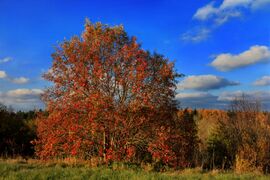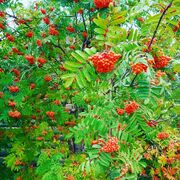Biology:Sorbus
| Sorbus | |
|---|---|

| |
| European rowan (Sorbus aucuparia) with fruit | |
| Scientific classification | |
| Kingdom: | Plantae |
| Clade: | Tracheophytes |
| Clade: | Angiosperms |
| Clade: | Eudicots |
| Clade: | Rosids |
| Order: | Rosales |
| Family: | Rosaceae |
| Subfamily: | Amygdaloideae |
| Tribe: | Maleae |
| Subtribe: | Malinae |
| Genus: | Sorbus L. |
| Subgenera | |
Sorbus is a genus of over 100 species of trees and shrubs in the rose family, Rosaceae. Species of Sorbus (s.l.) are commonly known as whitebeam, rowan, mountain-ash and service tree. The exact number of species is disputed depending on the circumscription of the genus, and also due to the number of apomictic microspecies, which some treat as distinct species, but others group in a smaller number of variable species. Recent treatments[1][2][3][4] classify Sorbus in a narrower sense to include only the pinnate leaved species of subgenus Sorbus, raising several of the other subgenera to generic rank.
Sorbus is not closely related to the true ash trees which belong to the genus Fraxinus, although the leaves are superficially similar.
Genus
As treated in its broad sense, the genus is divided into two main and three or four small subgenera:
- Sorbus (Sorbus)
- now genus Sorbus s.s., are commonly known as the rowan (primarily in the UK) or mountain-ash (in Ireland, North America and the UK), with compound leaves usually hairless or thinly hairy below; fruit carpels not fused; the type is Sorbus aucuparia (European rowan). Distribution: cool-temperate Northern Hemisphere.
- Sorbus (Aria)
- now genera Aria and Hedlundia, the whitebeams, with simple leaves usually strongly white-hairy below (hence the name, from German Weissbaum, 'white tree'); fruit carpels not fused; the type is Sorbus aria (common whitebeam). Distribution: temperate Europe & Asia.
- Sorbus (Micromeles)
- now genus Micromeles, a group of a east Asian species with narrow leaves; sometimes previousy included in subgenus Aria. Distribution: temperate and tropical east Asia.
- Sorbus (Cormus)
- now genus Cormus, with compound leaves similar to subgenus Sorbus, but with distinct fused carpels in the fruit; just one species, Cormus domestica (true service tree). Distribution: North Africa, warm-temperate Europe, western Asia.
- Sorbus (Torminaria)
- now genus Torminalis, with rather maple-like lobed leaves with pointed lobes; fruit carpels not fused; just one species (wild service tree). Distribution: temperate Europe, south to the mountains of North Africa and east to the Caucasus ranges.
- Sorbus (Chamaemespilus)
- now genus Chamaemespilus, monotypic, with a single shrubby species, false medlar. Has simple, glabrous leaves and pink flowers with erect sepals and petals. Distribution: mountains of southern Europe.
Hybrids are common in the genus, including many between the subgenera; very often these hybrids are apomictic (self-fertile without pollination), so able to reproduce clonally from seed without any variation. This has led to a very large number of microspecies, particularly in western Europe (including Britain) and parts of China.
Sorbus species are used as food plants by the larvae of some moth species—see list of Lepidoptera that feed on Sorbus. Sorbus domestica is used to flavour some apple wines, see Apfelwein.
Uses
Ornamental trees
Sorbus species are cultivated as ornamental trees for parks and gardens and as avenue trees, and have given rise to several cultivars. The following, of mixed or uncertain parentage, have gained the Royal Horticultural Society’s Award of Garden Merit:[5]
- ’Eastern Promise’[6] (purple autumn colour, pink berries)
- ’Leonard Messel’[7] (small tree to 4m, pink berries)
- ’Wisley Gold’ [8] (yellow berries)
Gallery
References
- ↑ Robertson, K. R., J. B. Phipps, J. R. Rohrer, and P. G. Smith. 1991. A Synopsis of Genera in Maloideae (Rosaceae). Systematic Botany 16: 376–394.
- ↑ McAllister, H. 2005. The Genus Sorbus: Mountain Ash and Other Rowans. Richmond, Surrey, UK: Royal Botanic Gardens, Kew.
- ↑ Potter, D., T. Eriksson, R. C. Evans, S.-H. Oh, J. E. E. Smedmark, D.R. Morgan, M. S. Kerr, and C. S. Campbell. (2007). Phylogeny and classification of Rosaceae. Plant Systematics and Evolution. 266(1–2): 5–43.
- ↑ Campbell C. S., R. C. Evans, D. R. Morgan, T. A. Dickinson, and M. P. Arsenault. 2007. Phylogeny of subtribe Pyrinae (formerly the Maloideae, Rosaceae): Limited resolution of a complex evolutionary history. Pl. Syst. Evol. 266: 119–145.
- ↑ "AGM Plants - Ornamental". Royal Horticultural Society. July 2017. p. 98. https://www.rhs.org.uk/plants/pdfs/agm-lists/agm-ornamentals.pdf.
- ↑ "RHS Plantfinder - Sorbus 'Eastern Promise'". https://www.rhs.org.uk/Plants/63856/i-Sorbus-i-Eastern-Promise/Details.
- ↑ "RHS Plantfinder - Sorbus 'Leonard Messel'". https://www.rhs.org.uk/Plants/25811/i-Sorbus-i-Leonard-Messel/Details.
- ↑ "RHS Plantfinder - Sorbus 'Wisley Gold'". https://www.rhs.org.uk/Plants/150218/i-Sorbus-i-Wisley-Gold/Details.
Further reading
| Wikimedia Commons has media related to Sorbus. |
- Price, D.T. 2007. One-way introgressive hybridisation between Sorbus aria and S. torminalis (Rosaceae) in southern Britain. Watsonia. 26: 419–431.
Wikidata ☰ Q157964 entry
 |



